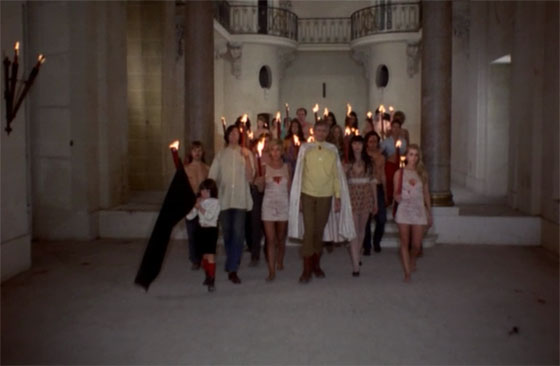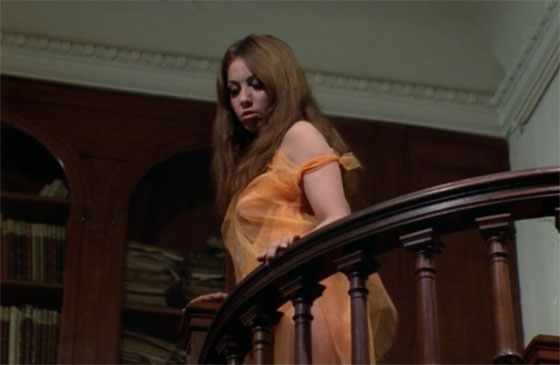 The impression one gets from Jean Rollin’s early films is that he wrote no screenplay, but worked instead from hastily-scribbled, vaguely-realized ideas in a notebook. This adds to both their charm and their incoherency. Rape of the Vampire (1968), his first full-length feature and the prologue in an extending series of vampire films, was a surrealistic, sometimes plodding journey through his nightmares and daydreams. Vampires abandoned in a decaying castle; vampires marching in a parade upon a beach, led by their Queen; vampires in a theater, conducting a wedding like a surrealistic play, interrupted by a violent, ’68-style riot; lust, paranoia, blood, and death. The film was not well-loved, but made enough money that he was encouraged to make a follow-up. That would be The Nude Vampire (La vampire nue, 1970), which once again made a commercial plea through its title, luring the unsuspecting raincoat crowd into another subversive and lysergic Gothic romp. French comic artist Druillet provided another fantastic poster, blending Art Nouveau with Avalon Ballroom-style psychedelia; personally, I would have found that a lot more alluring than the title. The film is another exercise in Rollin’s personal fetishes, with a plot that’s only slightly easier to follow than its predecessor; nevertheless, it’s an important film for Rollin as it addressed some of Rape of the Vampire‘s problems while taking major steps forward in realizing his own unique style.
The impression one gets from Jean Rollin’s early films is that he wrote no screenplay, but worked instead from hastily-scribbled, vaguely-realized ideas in a notebook. This adds to both their charm and their incoherency. Rape of the Vampire (1968), his first full-length feature and the prologue in an extending series of vampire films, was a surrealistic, sometimes plodding journey through his nightmares and daydreams. Vampires abandoned in a decaying castle; vampires marching in a parade upon a beach, led by their Queen; vampires in a theater, conducting a wedding like a surrealistic play, interrupted by a violent, ’68-style riot; lust, paranoia, blood, and death. The film was not well-loved, but made enough money that he was encouraged to make a follow-up. That would be The Nude Vampire (La vampire nue, 1970), which once again made a commercial plea through its title, luring the unsuspecting raincoat crowd into another subversive and lysergic Gothic romp. French comic artist Druillet provided another fantastic poster, blending Art Nouveau with Avalon Ballroom-style psychedelia; personally, I would have found that a lot more alluring than the title. The film is another exercise in Rollin’s personal fetishes, with a plot that’s only slightly easier to follow than its predecessor; nevertheless, it’s an important film for Rollin as it addressed some of Rape of the Vampire‘s problems while taking major steps forward in realizing his own unique style.
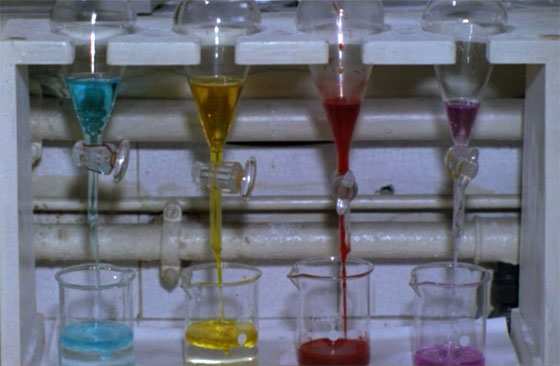
A psychedelic treatment in a secret laboratory.
A mysterious opening is one of several sequences which resemble Holy Mountain-era Jodorowsky. A blue-hooded woman is in a laboratory of some kind, surrounded by men in red and black hoods. She’s stripped of her dress. A blood sample is taken. We see multi-colored fluids distributed into jars; Rollin, apparently, has shaken off black-and-white for good. Then we glimpse a red-headed girl (Caroline Cartier) in a transparent orange nightgown slipping out of a gate in a wall, and sneaking off down the sidewalk and into the nighttime streets. Men in black clothes and animal masks pursue her: a rooster, a stag, a jackal, a fly, a donkey, a cow. She passes a young man on a staircase leading off the street, and looks at his face, touching it in astonishment. He goes with her into an alley, where they face off with the silent masked pursuers. The improvisational jazz score goes wild. The man in the elk mask shoots the girl, and she drops to the ground; the animal-men carry her body away, and the helpless young man follows them back to the gated estate, where he is denied admittance by a guard.
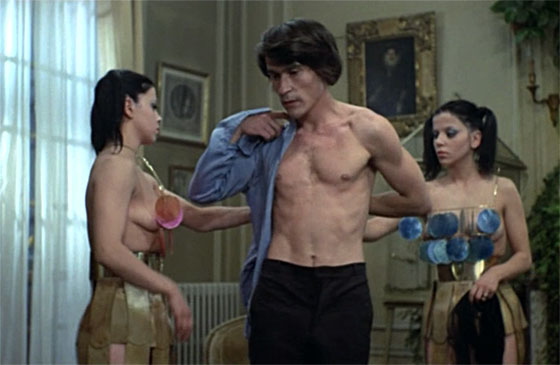
Pierre (Olivier Rollin) is attended by his father's twin servants (Catherine and Marie-Pierre Castel).
The next morning, the young man, whose name is Pierre (Olivier Rollin), confronts his wealthy father, Georges Radamante (Maurice Lemaître), since the place where the animal-men took refuge was Radamante’s private club. The father tells his son to mind his own business, and returns to the club with his two compatriots, Fredor (Jean Aron, looking like Dr. Strangelove) and Voringe (Bernard Musson), where they relax with drinks while watching the least-erotic dancing ever invented (a woman in a transparent, full-body leotard and Raggedy Ann hair writhes to a drumbeat while wearing conical pink pasties). After the dancer collapses to the floor – so exhausting was her writhing – their white-suited, freckled assistant, Solange (Ursule Pauly), arrives to receive her instructions from Radamante. Then she goes backstage and inspects the waiting dancers, one of whom, we learn, is a spy infiltrating the club. In the evening, everyone gathers once more in the gated building, but this time Pierre successfully breaks in, disguising himself as one of the guests. It seems it might be a very Eyes Wide Shut affair. When Pierre follows the guests into a small room, he sees a projector switched on, and the image of a blonde woman appears. Then that same woman steps out of the crowd, stands beside her own image, and shoots herself in the head. A hood is pulled over the dead woman’s face, and everyone assembled dons a hood as well. The corpse is taken into the main hall where the men in animal masks present that same mysterious redhead whom Pierre attempted to save the night before. Even though she’d been shot, she’s quite alive, and steps down the staircase to drink the spilled blood upon the body.
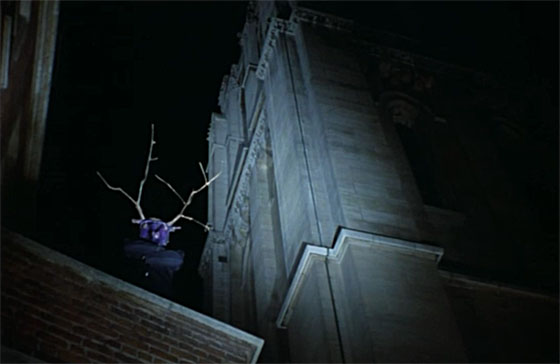
A man in a stag's mask keeps watch from the high walls of the secret club.
To complete this dream-like progression of events, everyone returns to the secret room, where now Pierre’s face is displayed from the projector. He’s handed the gun. As he steps before them, he breaks the cycle and fires the gun into the belly of the man beside him, then shoots randomly into the crowd of cultists and sprints out of the room, onto a walkway above the walls of the old building. Here the stag-faced man confronts him with a switchblade, a sentence I never thought I’d write. Pierre is out of bullets, but the adversary is slain by an Asian woman with a curved, sacrificial blade. “You must leave here!” she warns, and Pierre flees. As he leaves by the main gate, a gray-haired man in a yellow turtleneck and a silver cape (Michel Delahaye) takes him by the shoulder and says, “You will find your father at his office, my son. Go there at once – other mysteries await you!” We are twenty-three minutes into the film.
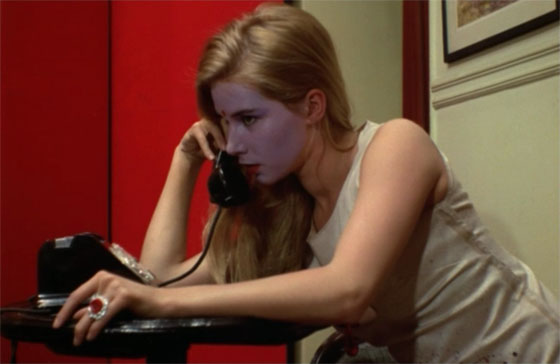
A spy posing as an exotic dancer infiltrates Radamante's townhouse.
Pierre heads to an office building to meet his friend Robert (Pascal Fardoulis), an artist who paints nude models (of course), and who’s researching the mysterious activities of the club. As they stare at photos taken of the redhead who drinks blood, Robert offers, “She could be a robot. That would explain why she’s invulnerable.” Pierre disagrees: “She put her hand on my cheek. I touched her. I know she can’t be a robot.” A buzzer sounds. Everyone gathers in the hallway, including Pierre and Robert, donning red hoods. The redhead is led down the hall by the rooster-man and the fly-man. The girl suddenly pulls off Robert’s hood, and smiles at him; a fight breaks out. Pierre is delivered to his father, where he’s given perfectly logical answers to all his questions. The girl is an orphan with a blood condition, which can heal her skin from bullet wounds (“just as long as no vital organ is hit”). As for all the animal masks and hoods – the girl is worshiped as a goddess by a suicide cult, and he has graciously loaned them his townhouse. He’s trying to cure her condition by searching for others who are like her. She can’t tolerate daylight, and “the hoods are to hide the faces of normal people from her. She has never seen a human face. She must not know that she is different from others.” It’s all so simple.
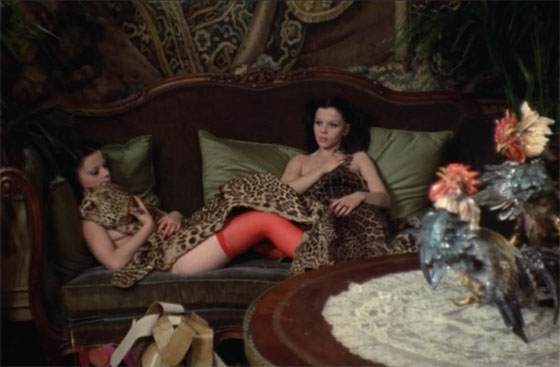
The Castel twins at rest.
Back at his townhouse, Radamante feels up his twin female servants while making plans to meet with a mysterious stranger in a country chateau. Those servants are played by Catherine and Marie-Pierre Castel, who will become mainstays of Rollin’s filmography. For the first half of the film they wander about in outfits which consist of Roman centurion skirts and sliding discs of glass hanging over their bare breasts. In the second half, they silently stalk about the grounds of the isolated chateau, holding candles: a Rollin trademark. Radamante orders Solange to kill Robert, and she does so, but not before telling him that the redhead is really a vampire, and that Radamante and his associates are holding her captive so they can learn the secret of immortality. At the chateau, the old men are wakened in the middle of the night by an ominous drumbeat. An army of vampires, led by the man in the silver cape, waits in the darkness, preparing to make their move. Pierre arrives, and later in the evening meets with the lord of the vampires, with whom he shares a mutual goal: to rescue the captive girl. After the chateau is finally besieged, Pierre is initiated into their sect by passing through a magical portal in a curtained theater attended by two kind, elderly immortals. This portal leads him back to the beach first seen in Rape of the Vampire, where he learns from the man in the silver cape that they are not really vampires – or robots – but part of a highly-evolved race of mutants. Or, as my wife put it, “Oh, he’s Magneto.”
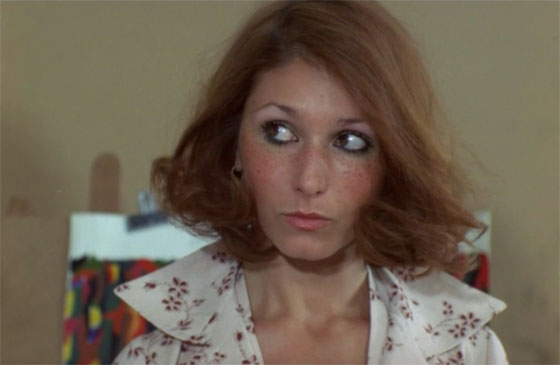
Ursule Pauly, as Solange, offers some further exposition before killing Robert.
Like Rape of the Vampire, The Nude Vampire offers one hypothesis and phony explanation after another until finally the “truth” is revealed, though the storytelling is less clumsy and more assured in its stream-of-consciousness fluidity. Rollin was becoming more skilled at translating his dreams directly onto film, and it’s the images that you’ll remember: the men in the animal masks stalking the vampiress through dark streets; the army of vampires carrying candles through the white corridors of the chateau; the Castel twins lying nude upon the floor like sleeping cats, in a circular chamber with a burning brazier in its center and painted, fetishistically-arranged baby dolls posed upon a table. It’s apparent to any viewer that you don’t need to decipher every moment; it’s a purely sensory experience. The languid tone – another Rollin trademark – is not to every taste, but that goes for everything Rollin; and anyway, the absurd dialogue is always diverting. This is a transitional film, but hallucinatory and gloriously weird. Having gained some traction here, Rollin’s next effort would be truly inspired.
